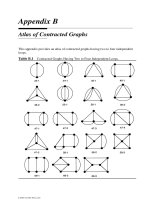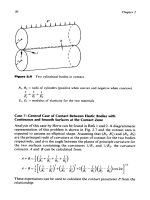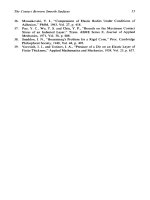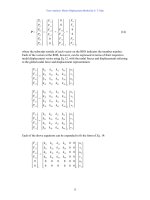ARNOLD, K. (1999). Design of Gas-Handling Systems and Facilities (2nd ed.) Episode 1 Part 2 doc
Bạn đang xem bản rút gọn của tài liệu. Xem và tải ngay bản đầy đủ của tài liệu tại đây (1.55 MB, 25 trang )
Heat
Transfer
Theory
1 1
Multiple
Transfer
Mechanisms
Most heat transfer processes used
in
production facilities involve combi-
nations
of
conduction
and
convection
transfer processes.
For
example,
in
heat exchangers
the
transfer
of
heat energy
from
the hot fluid to the
cold
fluid
involves three steps. First,
the
heat energy
is
transferred
from
the hot
fluid to the
exchanger tube, then through
the
exchanger tube
wall,
and
finally
from
the
tube wall
to the
cold
fluid. The
first
and
third steps
are
convection
transfer
processes,
while
the
second step
is
conduction process,
To
calculate
the
rate
of
heat transfer
in
each
of the
steps,
the
individual
temperature
difference
would have
to be
known.
It is
difficult
to
measure
accurately
the
temperatures
at
each boundary, such
as at the
surface
of
the
heat exchanger tube. Therefore,
in
practice,
the
heat transfer calcula-
tions
are
based
on the
overall temperature
difference,
such
as the
differ-
ence
between
the hot and
cold
fluid
temperatures.
The
heat
transfer
rate
is
expressed
by the
following
equation,
similar
to the
conductive/convec-
tive
transfer process:
where
q =
overall heat transfer rate,
Btu/hr
U =
overall heat transfer coefficient,
Btu/hr-ft
2
-°F
A
=
heat transfer area,
ft
2
AT
=
overall temperature
difference,
°F
Examples
of
overall heat transfer coefficient
and
overall temperature
difference
calculations
are
discussed
in the
following
sections.
Overall
Temperature
Difference
The
temperature difference
may not
remain constant throughout
the
flow
path. Plots
of
temperature
vs.
pipe
length
for a
system
of two
concen-
tric
pipes
in
which
the
annular
fluid is
cooled
and the
pipe
fluid
heated
are
shown
in
Figures
2-2 and
2-3. When
the two fluids
travel
in
opposite
direc-
tions,
as in
Figure 2-2, they
are in
countercurrent
flow.
When
the fluids
travel
in the
same
direction,
as in
Figure
2-3, they
are in
co-current
flow.
The
temperature
of the
inner pipe
fluid in
either case varies according
to
one
curve
as it
proceeds
along
the
length
of the
pipe,
and the
tempera-
ture
of the
annular
fluid
varies according
to
another.
The
temperature dif-
ference
at any
point
is the
vertical distance between
the two
curves.
12
Design
of
GAS-HANDLING
Systems
and
facilities
Figure 2-2. Change
in AT
over
distance,
counter-current
flow of fluids.
Since
the
temperature
of
both fluids changes
as
they flow through
the
exchanger,
an
"average"
temperature difference must
be
used
in
Equation
2-3.
Normally
a log
mean temperature difference
is
used
and can be
found
as
follows:
where
LMTD
= log
mean temperature difference,
°F
ATj
=
larger terminal temperature difference,
°F
AT
2
=
smaller terminal temperature difference,
°F
Although
two
fluids
may
transfer heat
in
either counter-current
or co-
current
flow, the
relative direction
of the two
fluids
influences
the
value
of
the
LMTD,
and
thus,
the
area required
to
transfer
a
given amount
of
Heat
Transfer
Theory
13
Figure
2-3.
Change
in AT
over
distance,
co-current
flow
of fluids.
heat.
The
following
example demonstrates
the
thermal
advantage
of
using
counter-current
flow.
Given:
A hot
fluid
enters
a
concentric pipe
at a
temperature
of
300°F
and
is to be
cooled
to
20Q°F
by a
cold
fluid
entering
at
100°F
and
heated
to
150°F.
Co-current
Flow:
Side
Hot
Fluid
Inlet
Hot
Fluid Outlet
Hot
Fluid
°F
300
200
Cold
Fluid
°F
100
150
AT
op
200
50
14
Design
oj
GAS-HANDLING
Systems
and
Facilities
Counter-current Flow:
Side
Hot
Fluid Inlet
Hot
Fluid
Outlet
Hot
Fluid
°F
300
200
Cold
Fluid
°f
150
100
AT
°F
150
100
Equation
2-4
assumes that
two
fluids
are
exchanging heat energy
while
flowing either co-current
or
counter-current
to
each other.
In
many
process applications
the
fluids
may flow
part
of the way in a
co-current
and the
remainder
of the way in a
counter-current
direction.
The
equa-
tions must
be
modified
to
model
the
actual
flow
arrangement.
For
pre-
liminary
sizing
of
heat transfer areas required, this correction factor
can
often
be
ignored. Correction factors
for
shell
and
tube heat exchangers
are
discussed
in
Chapter
3.
Overall
Heat
Transfer Coefficient
The
overall heat transfer coefficient
is a
combination
of the
internal
film
coefficient,
the
tube wall thermal conductivity
and
thickness,
the
external
film
coefficient,
and
fouling factors. That
is, in
order
for the
energy
to be
transferred through
the
wall
of the
tube
it has to
pass
through
a
film
sitting
on the
inside wall
of the
tube. That
film
produces
a
resistance
to the
heat transfer, which
is
represented
by the
inside
film
coefficient
for
this
convective
heat transfer.
It
then must pass through
the
wall
of the
tube
by a
conduction
process which
is
controlled
by the
tube-
wall's thermal conductivity
and
tube-wall thickness.
The
transfer
of
heat
from
the
outside wall
of the
tube
to the
bulk
of the fluid
outside
is
again
a
convective process.
It is
controlled
by the
outide
film coefficient.
All
of
these
resistances
are
added
in
series, similar
to a
series
of
electrical resis-
tance,
to
produce
an
overall resistance.
The
heat transfer coefficient
is
similar
to the
electrical conductance,
and its
reciprocal
is the
resistance.
Therefore,
the
following
equation
is
used
to
determine
the
overall heat
transfer
coefficient
for use in
Equation
2-3.
Heal
Transfer Theory
1 5
where
hj
=
inside
film
coefficient,
Btu/hr-ft
2
-°F
h
0
=
outside
film
coefficient,
Btu/hr-ft
2
-°F
k
=
pipe wall thermal conductivity,
Btu/hr-ft-°F
L =
pipe wall thickness,
ft
Rj
=
inside fouling resistance,
hr-ft
2
-°F7Btu
R
0
=
outside
fouling
resistance,
hr-ft
2
-°F/Btu
Aj
=
pipe inside surface area,
ft
2
/ft
A
()
=
pipe outside surface
area,
ft
2
/ft
Rj
and
R
0
are
fouling factors. Fouling factors
are
normally included
to
allow
for the
added resistance
to
heat
flow
resulting
from
dirt, scale,
or
corrosion
on the
tube walls.
The sum of
these
fouling
factors
is
normally
taken
to be
0.003
hr-ft
2
-°F/Btu,
although this value
can
vary widely with
the
specific
service.
Equation
2-5
gives
a
value
for
"U"
based
on the
outside surface area
of
the
tube,
and
therefore
the
area used
in
Equation
2-3
must
also
be the
tube
outside surface area. Note that Equation
2-5 is
based
on two
fluids
exchanging heat energy
through
a
solid divider.
If
additional heat
exchange steps
are
involved,
such
as for
finned
tubes
or
insulation, then
additional terms must
be
added
to the
right side
of
Equation
2-5.
Tables
2-1
and 2-2
have basic tube
and
coil
properties
for use in
Equation
2-5
and
Table
2-3
lists
the
conductivity
of
different
metals.
Inside
Film
Coefficient
The
inside
film
coefficient represents
the
resistance
to
heat
flow
caused
by the
change
in flow
regime
from
turbulent
flow in the
center
of
the
tube
to
laminar
flow at the
tube surface.
The
inside
film
coefficient
can
be
calculated
from:
16
Design
of
GAS-HANDLING
Systems
and
Facilities
Table
2-1
Characteristics
of
Tubing
Tube
OD
In,
!4
!4
!/
14
>^
•)H
yfc
y»
14
'X
'/2
J4.
)<:
%
;i/
%
%
/i
/i
.V
,/H
%
3
/
-X4
%
%
/i
/'4
;/4
•%
/'i
3/;
|
s
I
i
1
1
1
1
B.W.G.
Gauge
22
24
26
27
18
20
22
24
16
18
20
22
12
13
14
15
16
17
18
19
20
10
11
12
13
14
15
16
17
18
20
8
10
11
12
13
14
15
16
Thickness
In.
.028
.022
.018
.016
.049
.035
,028
.022
.065
.049
.035
.028
.109
.095
.083
.072
.065
.058
.049
.042
.035
,134
.120
.109
.095
.083
.072
.065
.058
.049
.035
.165
.134
.120
.109
.095
.083
.072
.065
internal
Area
!n.
2
.0295
.0333
.0360
.0373
.0603
.0731
.0799
.0860
.1075
.1269
.1452
.1548
.1301
.1486
.
1
655
.1817
.1924
.2035
.2181
.2298
.2419
.1825
.2043
.2223
.2463
.2679
.2884
.3019
.3157
.3339
.3632
.3526
.4208
.4536
.4803
.5153
.5463
.5755
,5945
Ft
2
External
Surface
PerFf
Length
.0655
.0655
.0655
.0655
.0982
.0982
.0982
.0982
.1309
.1309
.1309
.1309
.1636
.1636
.1636
.1636
.1636
.1636
.1636
.1636
.1636
.1963
.3963
.1963
.1963
.
1
963
.3963
.1963
.3963
.1963
.1963
.2618
.2618
.2618
.2618
.2618
.2618
.2618
.2618
Ft
3
Internal
Surface
Per Ft
Length
.05U8
.0539
.0560
.0570
.0725
.0798
.0835
.0867
.0%9
.1052
.
11
2o
.1162
.1066
.
1 ! 39
.1202
.
!
259
. i 296
.1333
.1380
.1416
.!453
.1262
.1335
.
1
393
.1466
.1329
.1587
.
i 623
.1660
.
1
707
.
1
780
i
754
.1916
.1990
.2047
.212!
.21
S3
.224!
.2278
Heat
Transfer
Theory
1 7
Table
2-1
(Continued)
Characteristics
of
Tubing
Tube
OD
In.
1
1
VA
V/4
VA
VA
114
114
VA
VA
VA
1!4
1!*
V/i
VA.
VA
2
7
2
2
8.W.G.
Gauge
18
20
1
8
10
11
12
13
14
16
18
20
10
12
14
16
11
12
13
14
Thickness
In.
.049
.035
.180
.165
.134
.120
.109
.095
.083
.065
.049
.035
.134
.109
.083
.065
.120
.109
.095
.083
Internal
Area
In,
2
.6390
.6793
.6221
.6648
.7574
.8012
.8365
.8825
.9229
.9852
1
.042
1.094
1.192
1.291
1
.398
1.474
2.433
2.494
2.573
2.642
Ft
2
External
Surface
Per Ft
Length
,2618
.2618
.3272
.3272
.3272
.3272
.3272
.3272
.3272
.3272
.3272
.3272
.3927
.3927
.3927
.3927
.5236
.5236
.5236
.5236
Ft
2
Internal
Surface
Per Ft
Length
.2361
.2435
,2330
.2409
.2571
.2644
.2702
.2775
.2,838
.2932
.3016
.3089
.3225
.3356
.3492
.3587
.4608
.4665
.4739
.480!
where
h
;
-
inside
film
heat
transfer
coefficient,
Btu/hr-ft
2
-°F
DJ
=
tube inside diameter,
ft
k
=
fluid
thermal conductivity,
Btu/hr-ft-°F
G
=
mass velocity
of fluid,
lb/hr-ft
2
C
= fluid
specific heat,
Btu/lb-°F
fi
e
= fluid
viscosity,
lb/hr-ft
ju
ew
= fluid
viscosity
at
tube
wall,
lb/hr-ft
(The viscosity
of a fluid in
lb/hr-ft
is its
viscosity
in
centipoise
times
2.41.)
The
bulk
fluid
temperature
at
which
the fluid
properties
are
obtained
should
be the
average temperature between
the fluid
inlet
and
outlet tem-
peratures.
The
viscosity
at the
tube wall should
be the fluid
viscosity
at
the
arithmetic average temperature between
the
inside
fluid
bulk
temper-
(text
continued
on
page
20)
18
Design
of
GAS-HANDLING
Systems
and
Facilities
Table
2-2
Pipe
Coil
Data
Norn,
Size
Sch.
OD
in.
No. in.
1
S40
1.315
X80
160
XX
2
S40
2.375
X80
160
XX
2
1
A
XXX
2.875
3 S40
3.50
X80
160
XX
4
S40
4.50
X80
160
XX
!D
in.
1
.049
0.957
0.815
0.599
2.067
1
.939
1.687
1
.503
1.375
3.068
2.900
2.624
2.300
4.026
3.826
3.438
3.152
Internal
Surface
Area
(f^/ft)
0.275
0.25
1
0.213
0.157
0.541
0.508
0.442
0.394
0.360
0.803
0.759
0.687
0.602
1.054
1
.002
0.900
0.825
External
Surface
Area
(fP/ft)
0.344
0,622
0.753
0.916
1.19
Table
2-3
Thermal
Conductivity
of
Metals
at
200°F
Material
Aluminum
(annealed)
Type
11
00-0
Type
3003-0
Type
3004-0
Type
606
1-0
Aluminum
(tempered)
Type
1
100
(all tempers)
Type
3003
(all tempers)
Type
3004
(all tempers)
Type
606
1-T4&T6
Type
6063-T5
& T6
Type
6063-T42
Cast
iron
Carbon
steel
Conductivity
Btu/hr-rr-°F
126
111
97
102
123
96
97
95
116
111
31
30
Heat
Transfer
Theory
19
Table
2-3
(Continued)
Thermal
Conductivity
of
Metals
at
200°F
Material
Carbon
rnoly
(
[
A%)
steel
Chrom
moly
steels
l%Cr,
M%Mo
2'4%Cr,
l%Mo
5% Cr,
M%
Mo
12%
Cr
Austenitic
stainless
steels
18%Cr,
8%Ni
25%
Cr, 20% Ni
Admiralty
Naval
brass
Copper
Copper
&
nickel alloys
90%
Cu,
10% Ni
80% Cu, 20% Ni
70% Cu, 30% Ni
30% Cu, 70% Ni
alloy
400
Muiitz
Aluminum
bronze alloy
D
alloy
E
Copper silicon alloy
B
Alloy
A, C, D
Nickel
Nickel-chrome-iron
alloy
600
Nickel-iron-chrome
alloy
800
Ni-Fe-Cr-Mo-Cu
alloy
825
Ni-Mo
alloy
B
Ni-Mo-Cr
alloy C-276
Cr-Mo alloy XM-27
Zirconium
Titanium
grade
3
Cr-Ni-Fe-Mo-Cu-Cb
alloy
20 CB
Conductivity
Btu/hr-ft-°F
29
27
25
21
14
9,3
7.8
70
71
225
30
22
18
15
71
46
22
33
21
38
9.4
7.1
7.0
6.4
11.3
12.0
11.3
7.6
20
Design
of
GAS-HANDLING
Systems
and
Facilities
(text
continued from page
17}
ature
and the
tube wall temperature.
The
tube wall temperature
may be
approximated
by
taking
the
arithmetic average between
the
inside
fluid
bulk
temperature
and the
outside
fluid
bulk temperature.
The
thermal
conductivity
of
natural
and
hydrocarbon
gases
is
given
in
Figure
2-5.
The
value from Figure
2-4 is
multiplied
by the
ratio
of
k/k.
A
from
Figure
2-5.
The
thermal conductivity
of
hydrocarbon liquids
is
given
in
Figure
2-6.
The
viscosity
of
natural gases
and
hydrocarbon
liquids
is
discussed
in
Volume
1.
Figure
2-4.
Thermal conductivity
of
natural
and
hydrocarbon
gases
at 1
atmosphere,
14.696 psia.
{From
Gas
Processors
Suppliers
Association,
Engineering
Data
Book,
10th
Edition.)
Heat
'Transfer
Theory
21
Figure 2-5. Thermal conductivity
ratio
for
gases.
{From
Gas
Processors
Suppliers
Association,
Engineering
Date
Book,
10th
Edition.)
The
mass velocity
of a
fluid
in
pounds
per
hour
per
square foot
can
be
calculated from
22
Design
of
GAS-HANDLING
Systems
and
Facilities
Figure
2-6.
Thermal
conductivities
of
hydrocarbon
liquids.
(Adapted
from
Nati.
Bur,
Sras.
Misc.
Pub.
97,
reprinted
from Process
Heof
Transfer
by
Kern,
McGraw-Hill,
Co.
©1950.)
where
Q] =
liquid
flow
rate
per
tube,
Bpd
Q
g
= gas flow
rate
per
tube,
MMscfd
SG
=
liquid specific gravity relative
to
water
S = gas
specific gravity relative
to air
D =
tube inside diameter,
ft
The
specific heat
of
natural
gas and
hydrocarbon liquids
can be
calcu-
lated
using procedures described later
in
this text (see
pp. 41 and
42).
The
physical
properties
and the
optimum temperature range
for
vari-
ous
heat transfer
fluids are
given
in
Table 2-4. Graphs showing more
detailed
physical properties
and
heat transfer coefficient
at
various condi-
tions, such
as
those shown
in
Figures
2-7
through 2-9,
can be
obtained
directly
from
manufacturers.
A
personal computer program
for
obtaining
detailed physical properties
of
Therminol
and for
computing
heat
transfer
coefficients
and
pressure drops
in a
wide variety
of
tube sizes
and flow
conditions using Therminol
as
the
heat transfer
fluid is
available
from
Monsanto
Company.
(text
continued
on
page
28)
Table
2-4
PronertiAs
of
S«m*»
Hftat
Transf**!*
Finici«
Product Name
Application
Composition
Max.
Temperature
Film
Bulk
Optimum
Use
Temp.
Range,
°F
Flash
Point,
COC
Fire
Point,
COC
Autoignition
Temp.
(ASTM)
Density,
Ib/gal
75°F
240°F
400°F
60TF
Heat
Capacity,
Btu/lb-°F
75°F
240°F
400°F
600°F
Therminol
55
Medium
Temp.
Range
Alkylated
Aromatics
635°F
550°F
-15°F
to
550°F
350°F
425
°F
690°F
7.25
6.74
6.22
5.69
f
0.459
0.537
0.612
0.682''
Therminoi
59
Wide
Temp.
Range
Alkylated
Aromatics
650°F
600°F
-50
D
F
to
600°F
280°F
325°F
760°F
8.11
7.55
6.98
6.18
0.405
0.476
0.547
0.640
Therminof
66
High
Temp.
Low
Press,
Modified
Terphenyl
705°F
650°F
30°F
to
650°F
363°F
414°F
750°F
8.40
7.88
7.36
6.64
0.377
0.452
0.528
0.628
Therminoi
VP-1
Ultra
High
Temp.
Byphenyl
and
Dipheynl
Oxide
800°F
750°F
54°F
to
750°F
255°F
260°F
1,150°F
8.86
8.23
7.59
6.68
0.372
0.435
0.492
0.563
Syltherm
800
High
Temp.
Long
Life
Polydimethyl
Siloxane
800°F
750°F
-40°F
to
750°F
320°F
725°F
7.79
7.11
6.43
5.45
0.386
0.423
0.460
0.505
UCON
HTF500
High
Temp.
Water
Soluble
Polyalkylene
Glycol
Polymer
()°F
to
500°F
575°F
600°F
750°F
8.60
7.98
7,39
7.00"
0.47
0.53
0.56
0.57
tf
Dowffierm
4000
Water-based
Heating/Cooling
Inhibited
Glycol-based
-60°F
to
350°F
40°F
9.26
180°F
8.84
250°F
8.47
3SO°F
8.12
40°F
0.762
180°F
0.835
250°F
0.872
350°F
0.925
(tahle
continued
on
next
pagt-i
Table
2-4
(Continued)
g
Properties
of
Some
Heat
Transfer
Fluids
Product
Name
Therminoi
55
Thermal Conductivity,
Btu/hr-ft-°F
75°F
0.0740
240°F
0.0678
400°F
0.0618
600°F
0.056
1'
Viscosity,
cps
75°F
240°F
400°F
600°F
Pour Point
Vapor
Pressure,
psia
240°F
400°F
600°F
Equivalent
Product
34.5
2.16
0.718
0.366
f
-65°F
0.010
0.360
3.74''
Dowtherm
T
Therminoi
59
0.0700
0.0656
0.0600
0.0513
6.17
1.08
0.461
0.231
-90°F
0.102
2.14
23.6
Dowtherm
J
Therminoi
66
0.0679
0.0650
0.0608
0.0535
100.4
2.630
0.825
0.379
-25°F
0.014
0.370
6.24
Dowtherm
HT
Therminoi
VP-1
0.0786
0.0727
0.0654
0.0540
3.900
0.823
0.383
0.206
54°F*
0.151
3.94
45.7
Dowtherm
A
Syltherm
800
0.0776
0.0676
0.0580
0.0459
9.4
2,48
1.01
0.420
-40°F**
i.O
15.0
87.0
UCON
HTF500
0.097
0.088
0.080
0.075"
113.0
8.6
3.0
2.0"
-55°F
<0.1
mmHg'
v
Dowtherm
4000
40°F
0.212
180°F
0.238
250°F
0.241
350°F
0.233
40°F
6.80
180°F
0.94
250°F
0.52
350°F
0.27
_34°F**
Boiling
Point:
225°F
''@
550°F
^Crystallizing
Point
"@
SOO°F
**Freezing
Point
Therminoi
is a
registered
trademark
of
Monsanto
Company.
Dowtherm
ami
Syltherm
are
registered
trademarks
of
Dow
Chemical
Company.
UCON
is
a
registered
trademark
oj
Union
Carbide.
Heat
Transfer
Theory
25
Figure
2-7. Heat transfer
coefficient
Monsanto
Therminol
55. Use
range
0°F
to
600°F;
maximum
film
temperature
635°F.
(From
Practical
Heat
Recovery,
John
L.
Boyen,
John
Wiley
&
Sons,
Inc.,
©
1975.)
26
Design
of
GAS-HANDLING
Systems
and
Facilities
Figure
2-8.
Heat
transfer
coefficient, Monsanto
Therminol
66.
Use
20°F
to
650°F;
maximum
film
temperature
705°F.
(From
Practical
Heat
Recovery,
John
L
Boyen,
John
Wiley
&
Sons,
Inc.,
©
1975.)
Heat Transfer Theory
27
Figure
2-9. Physical
properties
Dowtherm
"G"
versus
temperature.
(From
Practical
Heat
Recovery,
John
L
Boyen,
John
Wiley
&
Sons, Inc.,
©
1975.)
28
Design
of
GAS-HANDLING
Systems
and
Facilities
(text
cominued
from
page
22)
Figure
2-10
gives
the
thermal conductivity, viscosity,
and
specific
heat
of
water.
Outside
Film
Coefficient
(in a
Liquid
Bath)
The
outside
film
coefficient
for a
process
coil
in a
liquid bath heater
is the
result
of
natural
or
free
convection. Temperature variations
in the fluid
cause
density
variations.
These
density variations
in
turn cause
the fluid to
circu-
late,
which produces
the
free convective heat transfer.
For
horizontal pipes
and
tubes spaced more than
one
diameter apart,
the
following
equation,
based
on
empirical studies,
may be
used
to
determine
the film
coefficient.
where
h
0
=
outside
film
coefficient,
Btu/hr-ft
2
-°F
k
=
bath
fluid
thermal conductivity,
Btu/hr-ft-°F
C
=
bath
fluid
specific heat,
Btu/lb-°F
p
=
bath
fluid
density,
lb/ft
3
P
=
bath
fluid
coefficient
of
thermal expansion,
1/°F
[i
=
bath
fluid
viscosity,
cp
AT
=
average temperature difference between
the fluid in the
coil
and the
liquid bath,
°F
d
()
=
pipe outside diameter,
in.
The fluid
properties
can be
determined
as
before, except
for the
bath
fluid
coefficient
of
thermal
expansion, which
is
given
in
Table 2-5.
The
density
of
water
is one
divided
by the
specific
volume
given
in
steam
tables (Table 2-6).
(text
continued
on
page
33)
Table
2-5
Coefficients
of
Thermal
Expansion
Fluid
Water
Dowtherms
Therminols
Mobiltherms
Coefficient
(1/°F)
0.0024
0.00043
0.00039
0.00035
Figure
2-10.
Physical properties
of
wafer.
Table
2-6
**
Properties
of Dry
Saturated
Steam
Temp,
F
t
32
35
40
45
50
60
70
80
90
100
110
120
130
140
150
160
170
180
190
200
210
212
Abs.
Press,
psia
P
0.08854
0.09995
0.12170
0.14752
0.17811
0.2563
0.3631
0.5069
0.6982
0,9492
1.2748
1.6924
2,2225
2.8886
3.718
4.741
5.992
7.510
9,339
1
1.526
14.
123
14.696
Specific
Volume
Sat.
Liquid
Vf
0.01602
0.01602
0.01602
0.01602
0.01603
0.01604
0.01606
0.01608
0.01610
0.01613
0.01617
0.01620
0.01625
0.01629
0.01634
0.01639
0.01645
0.01651
0.01657
0.01663
0.01670
Evap
v
%
3306
2947
2444
2036.4
1703.2
1206.6
867.8
633.1
468.0
350.3
265.3
203.25
157.32
122.99
97,06
77.27
62.04
50,21
40.94
33.62
27,80
0.01672
I
26.78
Sot.
Vapor
v
g
3306
2947
2444
2036,4
1703.2
1206.7
867,9
633.1
468.0
350.4
265.4
203.27
157.34
123,01
97.07
77.29
62.06
50.23
40.96
33.64
27.82
26.80
Enthalpy
Sat.
Liquid
0.00
3.02
8.05
13.06
18,07
28.06
38.04
48,02
57.99
67.97
77.94
87.92
97.90
107.89
117.89
127.89
137.90
147.92
157.95
167.99
178.05
180.07
Evap.
hfg
1075,8
1074.1
1071.3
1068,4
1065.6
1059.9
1054.3
1048.6
1042.9
1037.2
1031,6
1025.8
1020.0
1014.1
1008.2
1002.3
996.3
990.2
984.1
977,9
971.6
970,3
Sat.
Vapor
kg
1075.8
1077.1
1079.3
1081.5
1083.7
1088.0
1092,3
1096.6
1100.9
1105.2
1109.5
1113.7
1117.9
1122,0
1126.1
1130.2
1134.2
1138.1
1
142.0
1
145.9
1149.7
1
1.50.4
Entropy
Sat.
Liquid
Sf
0.0000
0.0061
0.0162
0.0262
0,0361
0.0555
0.0745
0.0932
0.1115
0.1295
0.1471
0.1645
0.1816
0,1984
0.2149
0.2311
0.2472
0.2630
0.2785
0,2938
Evap.
%
2.1877
2.1709
2.1435
2,1167
2.0903
2.0393
1.9902
1.9428
1.8972
1.8531
1.8106
1.7694
1.7296
1.6910
1.6537
1.6174
1.5822
1,5480
1.5147
1,4824
0.3090
]
0.3120
;
1.4446
Sat.
Vapor
s
g
2.1877
2.1770
2.1597
2,1429
2,1264
2.0948
2,0647
2.0360
2.0087
1
.9826
1.9577
1.9339
1.9112
1.8894
1,8685
1.8485
1.8293
1.8109
1.7932
!
.7762
1.7598
1.7566
Temp.
F
t
32
35
40
45
50
60
70
80
90
100
110
120
130
140
150
160
170
180
190
200
210
-7
j
•-)
Table
2-6
(Continued)
Properties
of Dry
Saturated
Steam
Temp.
F
t
20
230
240
250
260
270
280
290
300
310
320
330
340
350
360
370
380
390
Abs.
Press,
psia
P
17.186
20.780
24.969
29.825
35.429
41.858
49.203
57.556
67.013
77.68
89.66
103.06
118.01
134.63
153.04
173.37
195.77
220.37
Specific
Volume
Sat.
Liquid
Vf
0.01677
0.01684
0.01692
0.01700
0.01709
0.01717
0.01726
0.01735
0.01745
0.01755
0.01765
0.01776
0.01787
0.01799
0.01811
0.01823
0.01836
0.01850
Evap
v
fg
23.13
19.365
16.306
13.804
1 1
.746
10.044
8.628
7.444
6.449
5.609
4.896
4.289
3.770
3.324
2.939
2.606
2.317
2.0651
Sot
Vapor
v
s
23.15
19.382
16.323
13.821
11.763
10.061
8.645
7.461
6.466
5.626
4,914
4.307
3.788
3.342
2.957
2.625
2.335
2.0836
Enthalpy
Sat.
Liquid
hf
188.13
198.23
208.34
216.48
228.64
238.84
249.06
259.31
269.59
279.92
290.28
300.68
311.13
321.63
332.18
342,79
353.45
364.17
Evap.
Hfg
965.2
958.8
952.2
945.5
938.7
931.8
924.7
917.5
910.1
902.6
894.9
887.0
879.0
870,7
862.2
853.5
844.6
835.4
Sat.
Vapor
h
s
1153.4
1157.0
1160.5
1164.0
1
167.3
1
170.6
1173.8
1176.8
1
179.7
1182.5
1185.2
1187.7
1190.1
1
192,3
1194.4
1196.3
1198.1
1
199.6
Entropy
Sat.
Liquid
Sf
0.3239
0.3387
0.3531
0.3675
0.3817
0.3958
0.4096
0.4234
0.4369
0.4504
0.4637
0.4769
0.4900
0.5029
0.5158
0.5286
0.5413
0.5539
Evap.
%
1.4201
1.3901
1.3609
1.3323
1.3043
1.2769
1.2501
1
.2238
1.1980
1.1727
1.1478
1.1233
1.0992
1.0754
1.0519
1.0287
1
.0059
0.9832
Sat.
Vapor
s
t
1.7440
1.7288
1.7140
1.6998
1.6860
1.6727
1.6597
1.6472
1.6350
1.6231
1.6115
1.6002
1
.5891
1.5783
1.5677
1.5573
1.5471
1.5371
Temp.
F
t
220
230
240
250
260
270
280
290
300
310
320
330
340
350
350
370
380
390
(fable
continued
on
next
page)
Table
2-6
(Continued)
Properties
of Dry
Saturated
Steam
Temp.
F
t
400
410
420
430
440
450
460
470
480
490
500
520
540
560
580
600
620
640
660
680
700
Abs.
Press,
psia
P
247.31
276.75
308.83
343.72
381.59
422.6
466.9
514.7
566.1
621.4
680.8
812.4
962.5
1133.1
1325.8
1542.9
1786.6
2059.7
2365.4
2708.1
3093.7
705.4
|
3206.2
Specific
Volume
Sat.
Liquid
Vf
0.01864
0.01878
0.01894
0.01910
0.01926
0.0194
0.0196
0.0198
0.0200
0.0202
0.0204
0.0209
0.0215
0.0221
0.0228
0.0236
0.0247
0.0260
0.0278
0.0305
0
0369
0.050^
Evap
%
1.8447
1.6512
1.4811
1.3308
1.1979
1.0799
0.9748
0.8811
0.7972
0.7221
0.6545
0.5385
0.4434
0.3647
0.2989
0.2432
0.1955
0.1538
0.1165
0.0810
0.0392
o
Sat.
Vapor
v
s
1.8633
1.6700
1.5000
1.3499
1.2171
1.0993
0.9944
0.9009
0.8172
0.7423
0.6749
0.5594
0.4649
0.3868
0.3217
0.2668
0.2201
0.798
0.1442
0.1115
0.0761
0.0503
Enthalpy
Sat.
Liquid
h
f
374.97
385.83
396.77
407.79
418.90
430.1
441.4
452.8
464.4
476.0
487.8
511.9
536.6
562.2
588.9
617.0
646.7
678.6
714.2
757.3
823.
*
902.7
Evap.
ttfg
826.0
816.3
806.3
796.0
785.4
774.5
763.2
751.5
739.4
726.8
713.9
686.4
656.6
624.2
588.4
548.5
503.6
452.0
390.2
309.9
172 1
L
_J?
Sat,
T
1201.0
1202.1
1203.1
1203.8
1204.3
1204.6
1204.6
1204.3
1203.7
1202.8
1201.7
1198.2
1
193.2
1186.4
1177.3
1165.3
1150.3
1130.5
1104.4
1067.2
995.4
Entropy
Sat.
Liquid
Sf
0.5664
0.5788
0.5912
0.6035
0.6158
0.6280
0.6402
0.6523
0.6645
0.6766
0.6887
0.7130
0.7374
0,7621
0.7872
0.8131
0.8398
0.8679
0.8987
Evap.
%
0.9608
0.9386
0.9166
0.8947
0.8730
0.8513
0.8298
0.8083
0.7868
0.7653
0.7438
0.7006
0.6568
0.6121
0.5659
0.5176
0.4684
0.4110
0.3485
0.9351
j
0.2719
0.9905
i
0.1484
Sat.
Vapor
%
1.5272
1.5174
1.5078
1.4982
1.4887
1.4793
1.4700
1.4606
1.4513
1.4419
1.4325
1.4136
1.3942
1.3742
1.3532
1.3307
1,3062
1
,2789
1.2472
1.2071
1,1389
|
902.7
;
{ 0
!
I
0580
Temp.
F
t
400
410
420
430
440
450
460
470
480
490
500
520
540
560
580
600
620
640
660
680
700
705.4
Dati.mthi
\tcttm
U,
l\,-,
.i'-\
I?
a,"-"i'
-
v/'/'v
-,"fr,>«
rhermodynamic
Pr^pertR-
«-
f
S^am
A
/
H
Keenr:
ct>>i
f
O
AY.**-
»M/i/^W»
l.ifir'WiU"
A
S<//M
ln<
,
W>
Heat
Transfer
Theory
33
(text
continued
from page
28)
Outside
Film
Coefficient
(Shell-and-Tube
Exchangers)
For
shell-and-tube
heat exchangers
with
shell-side
baffles,
the
shell-
side
fluid flow is
perpendicular
to the
tubes.
In
this arrangement,
the
out-
side
film
coefficient
can be
calculated
from
the
following
equation;
where
h
0
=
outside
film
coefficient,
Btu/hr-ft
2
-
°F
D
=
tube
outside diameter,
ft
k
= fluid
thermal
conductivity,
Btu/hr-ft-°F
G
max
=
maximum
mass velocity
of fluid,
lb/hr-ft
2
C
= fluid
specific heat,
Btu/lb
°F
|H
e
=
fluid
viscosity,
lb/hr-ft
K
=
coefficient
from
Table
2-7
Table
2-7
Value
of K for
Fluid
Flow
Perpendicular
to a
Bank
of
Staggered
Tube
"N"
Rows
Deep
N
K
1
0.24
2
0.27
^
'"}
0.29
4
0.30
5
0.31
6
0.32
10
0.33
Approximate
Overall
Heat
Transfer
Coefficient
The
calculation
of
overall heat transfer coefficient
U
using
the
equa-
tions previously presented
can be
rather tedious. Heat transfer
specialists
have
computer programs
to
calculate
this
value. There
are
some quick
approximation techniques. Table
2-8
comes
from
the Gas
Processors
Suppliers
Association's Engineering Data
Book
and
gives
an
approxi-
mate
value
of U for
shell
and
tube heat exchangers.
It can be
seen
from
the
table that exchanging water with
100-psi
gas
gives
a low U
value. Thus,
a
high surface area
is
required. Exchanging
water with
1,000
psi gas
gives
a
much higher
U
value
and
less
surface
area
can
be
used
in the
exchanger.
If
water
is
being exchanged
with
34
Design
of
GAS-HANDLING
Systems
and
Facilities
Table
2-8
Typical
Bare-Tube
Overall
Heat-Transfer
Coefficients,
U for
Shell
and
Tube
Heat
Exchangers
Btu/hr-ft
2
-°F
Service
Water
with
100-psi
gas
Water with
300-psi
gas
Water
with
700-psi
gas
Water with
1
,000-psi
gas
Water with
kerosine
Water
with
M.EA
Water
with
air
Water with water
Oil
with
oil
C
3
with
C
3
liquid
Water condensers with
C
3
,
C
4
Water
condensers with naphtha
Water
condensers with
still
ovhd.
Water condensers with
arnine
Reboilers
with
steam
Reboilers
with
hot oil
1
00-psi
gas
with
500-psi
gas
1,000-psi
gas
with
1,000-psi
gas
1
,000-psi
gas
chiller
(gas-C
3
)
MEA
exchanger
U
35-40
40-50
60-70
80-100
80-90
1.30-150
20-25
180-200
80-100
110-130
125-135
70-80
70-80
100-110
140-160
90-120
50-70
60-80
60-80
120-130
Maximum boiling
film
transfer
coefficient
Hydrocarbons—300
to
500Btu/hr-fi
2
-°F
Water—2,000
Btu/hr-ft
2
-°F
water,
a
very high
U
value
is
achieved. Water with
air
gives
a
very
low U
value.
Oil
with
oil is
much less than water with water, because
of the
vis-
cous nature
of the
oil.
The
approximate
U
values
in the
table
do not
differentiate between
tube-side
and
shell-side fluids. Which
fluid
is on the
inside
of the
tubes
and
which
is on the
outside does make
a
difference
to the U
value. This
is
beyond
the
accuracy
of the
table.
Figure
2-11
gives values
of
U
for
exchange from
a
water bath
to a
nat-
ural
gas
stream
in a
coil.
Figure
2-12
is a
nomograph
for
crude
oil
streams
heated with
a
water bath.
Heat
Transfer
Theory
35
Figure
2-11.
Values
of U for
exchange from
wafer
bath
to
natural
gas
stream
in a
coil.
{Courtesy
of
Smith
Industries,
Inc.]
PROCESS
HEAT
DUTY
The
process heat
duty
is the
heat required
to be
added
or
removed
from
the
process
fluids
to
create
the
required change
in
temperature. This
can
be in the
form
of
sensible heat, latent heat,
or
both.
Sensible
Heat
The
amount
of
heat absorbed
or
lost
by a
substance that causes
a
change
in the
temperature
of the
substance
is
sensible heat.
It is
called
sensible heat because
it can be
measured
by the
change
in
temperature
it
causes.
For
example,
as
heat
is
added
to a
piece
of
steel
the
temperature
of
that
steel increases
and can be
measured.
The
general equation
for
cal-
culating
sensible heat
is:









